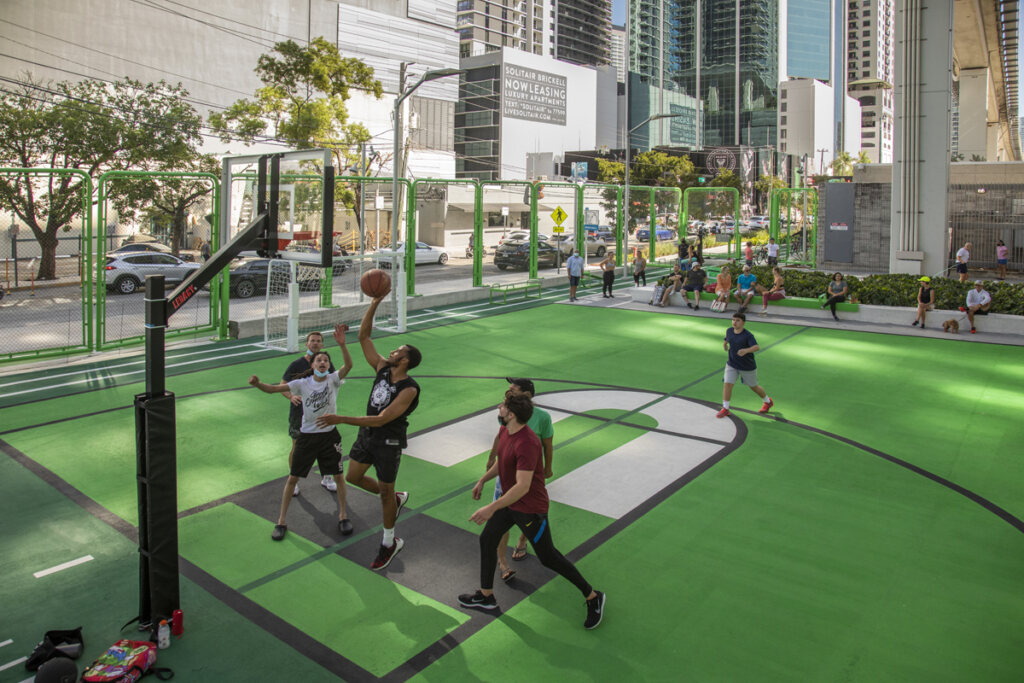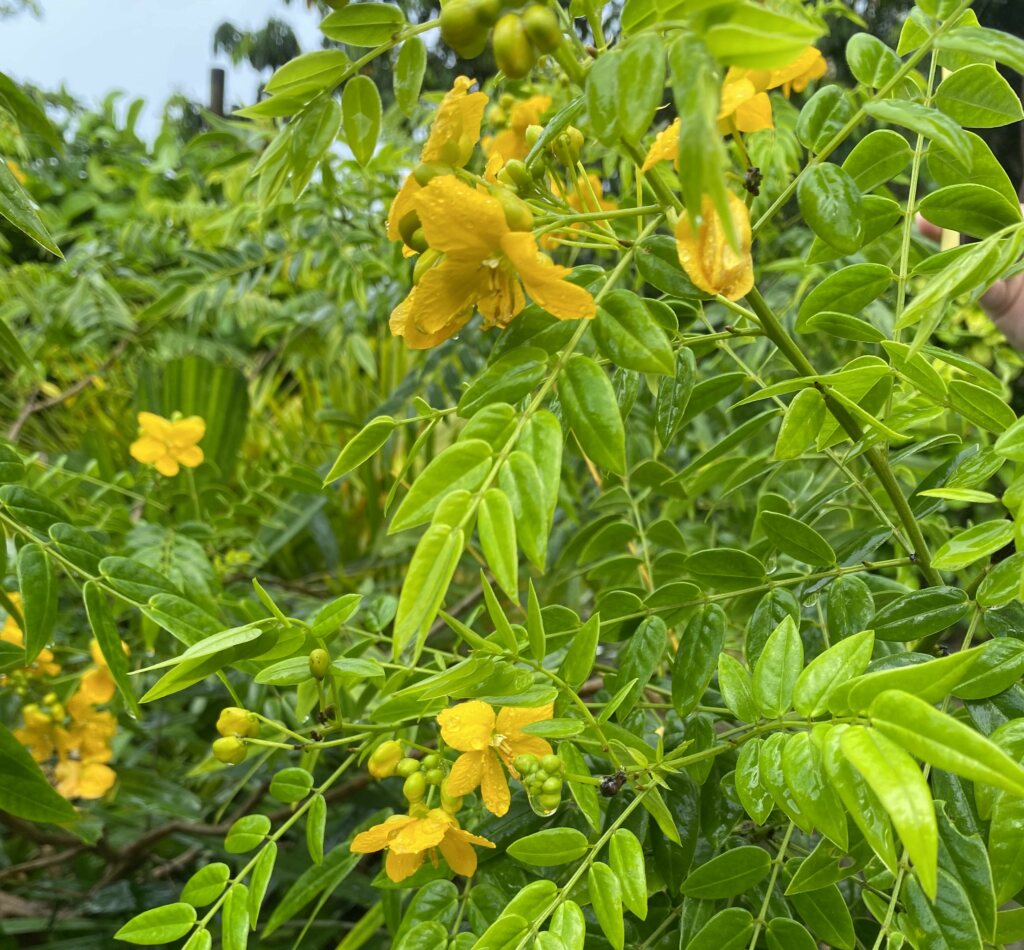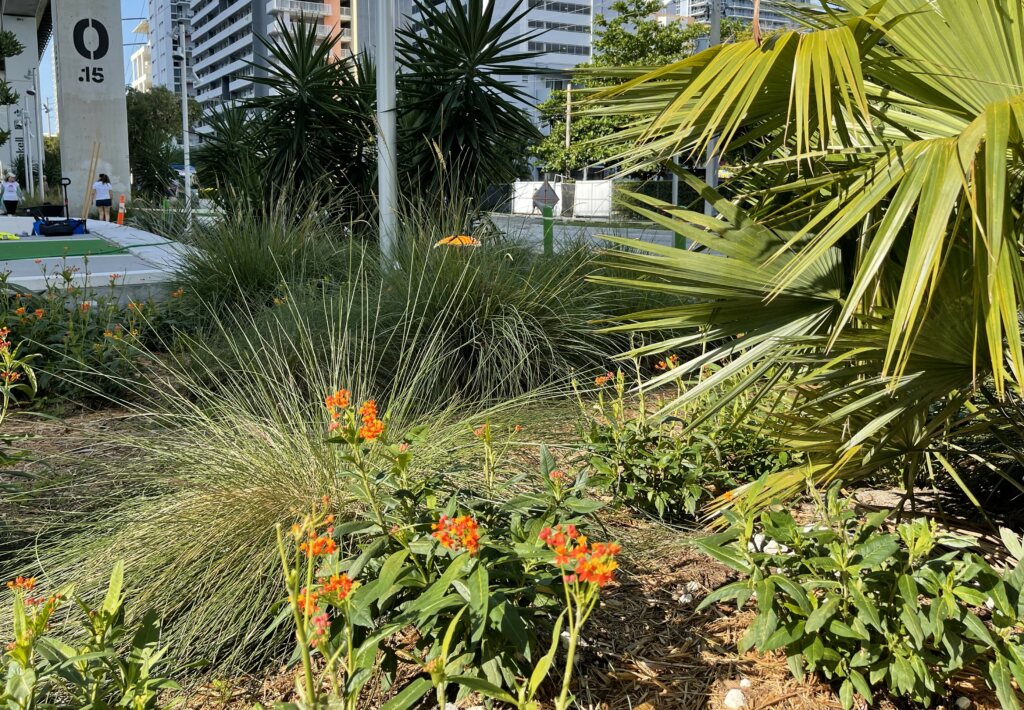Urban Gym
between SW 8th St and SW 7th St
Shoot some hoops, score a gooooooooooooal, or go for a jog in our Urban Gym. But don’t forget to smell the flowers and keep an eye out for some of the elegant butterflies that call this space home!

The Sulphur Butterfly and Senna plants
Hey! Have we met? I am the Sulphur butterfly, and I am one of Florida’s most common butterfly species! My scientific name is Phoebis sennae, but you can call me Phoebe.
Phoebis comes from the Greek goddess Phoebe, who was the sister of the sun god Apollo in Greek and Roman mythology. Like the sun, my wings are a bright light yellow color. I am much bigger than the Cassius Blue butterfly, so I am much easier to spot. Look up! I like to fly fast and high in the trees and swoop down to say hi.
The “sennae” part of my name refers to our relationship with the Senna plants. These are the plants we lay our eggs on and the first place our caterpillars call home.
Senna are a group of shrubs and small trees. They are in the same family as the bean plants, just like your green string beans, your frijoles negros, and your pwa congo! But not all beans are edible for humans. Sennas are actually poisonous for people and other insects to eat. But guess what? Senna plants are not poisonous to Sulphur butterflies. In fact, when we are caterpillars they are our favorite food! We can eat them without getting sick. Amazingly, as we eat the toxin it becomes part of our bodies and it gives us protection by making our bodies poisonous to other animals who might want to eat us. As caterpillars, we are chunky and bright greenish-yellow with a long yellow stripe along our bodies. Take a peek in the cassia bushes here, you might find one or two of us chomping on the leaves.
Sulphur butterflies love red flowers, like scarlet salvia (Salvia coccinia). One thing that makes us special, is our very long tongue that can reach nectar in long tubular flowers that other butterflies cannot reach. It is like a straw for butterflies and it is called a “proboscis” (Slurpees, anyone?)
Snap a pic! Post your pics and be sure to tag us! #climatechamps @theunderlinemia


Metamorphosis

Metamorphosis is an incredible change that all butterflies go through in order to grow out of their child caterpillar stage and become adult butterflies. A complete metamorphosis involves four stages: 1. egg; 2. larvae; 3. pupa; and 4. adult.
The process begins when a tiny egg is laid on a leaf by a mother butterfly. She lays her eggs on a host plant, a specific type of plants that her babies need to eat.
After hatching from the eggs, hungry caterpillars emerge and their only job is to eat and get chunky and strong for the next phase of life. As soon as they hatch, they begin to eat the host plant that they were laid on. This is the only thing they eat and they cannot move to another species of plant if they run out of food from this plant. After a few weeks the caterpillars will have fully grow and enter their next Pupa stage. Now they must find a safe place to build a chrysalis. A chrysalis is like a protective shell the caterpillar closes around itself while it completes its transformation.
Safe inside the chrysalis, something crazy happens. The caterpillar creates a juice to digest its whole body into a living soup! This allows the cells to reorganize and make a new body with legs, antennae, and beautiful wings. Once this transformation is complete, the changed creature breaks out of the chrysalis as a brand new butterfly!
Did you know that most insects go through a process of metamorphosis to become adults? Caterpillars are the larval stage of butterflies, but grubs are the larval stage of beetles. Even ladybugs go through metamorphosis. Ladybug larvae look like creepy aliens before they turn into the red and black polka dot bugs that we know so well. Can you imagine if we looked so different as kids? What would our baby photos look like??
Source: University of Florida. IFAS Extension
Recycling
You know another cool kind of metamorphosis? Recycling!
Recycling changes a used thing into a new thing! It is the process of collecting materials and making them into something else. And this is something we all can do to help decrease garbage and pollution.
There are many different ways to recycle depending on where you live. Five types of items cann be recycled: paper, cardboard, cans, cartons, and bottles. You don’t even need to separate them. It is an easy way to make a difference, and create new products!
Paper can be recycled to make egg cartons, cardboard, or even other types of recycled paper, like construction paper. Aluminum cans are mostly recycled into new aluminum cans, but they can also be turned into car parts and even airplane parts!
More and more people are recycling, and it is making a difference. Recycling has grown by 300% in the past 38 years. In 2018, more than 52 million tons of paper products were recycled. That’s the weight equivalent to 350,000 blue whales, the world’s largest animal. The United States recycles enough iron each year to build more than 900 Golden Gate Bridges. That’s a lot of metal!
Recycling is just one important part of the Five “R”’s of Sustainability: Refuse, Reduce, Reuse, Recycle and Rot.
Refuse– Don’t buy items that can’t be recycled unless you have to. And you can bring your own bags when you go grocery shopping so you don’t need to use the plastic bags from the store.
Reduce– If you don’t need it, don’t buy it!
Reuse– Before you toss it in the recycling bin, see if you can find creative ways to recycle items yourself. For example, you can save old paper and make a paper mache lampshade! Or reuse glass jam jars to store your coins.
Rot– Organic waste like banana peels and apple cores can be recycled directly back into the earth. It’s called composting!
These 5 Rs help us take care of our planet and keep it healthier. Now that you know, you can do them too.
